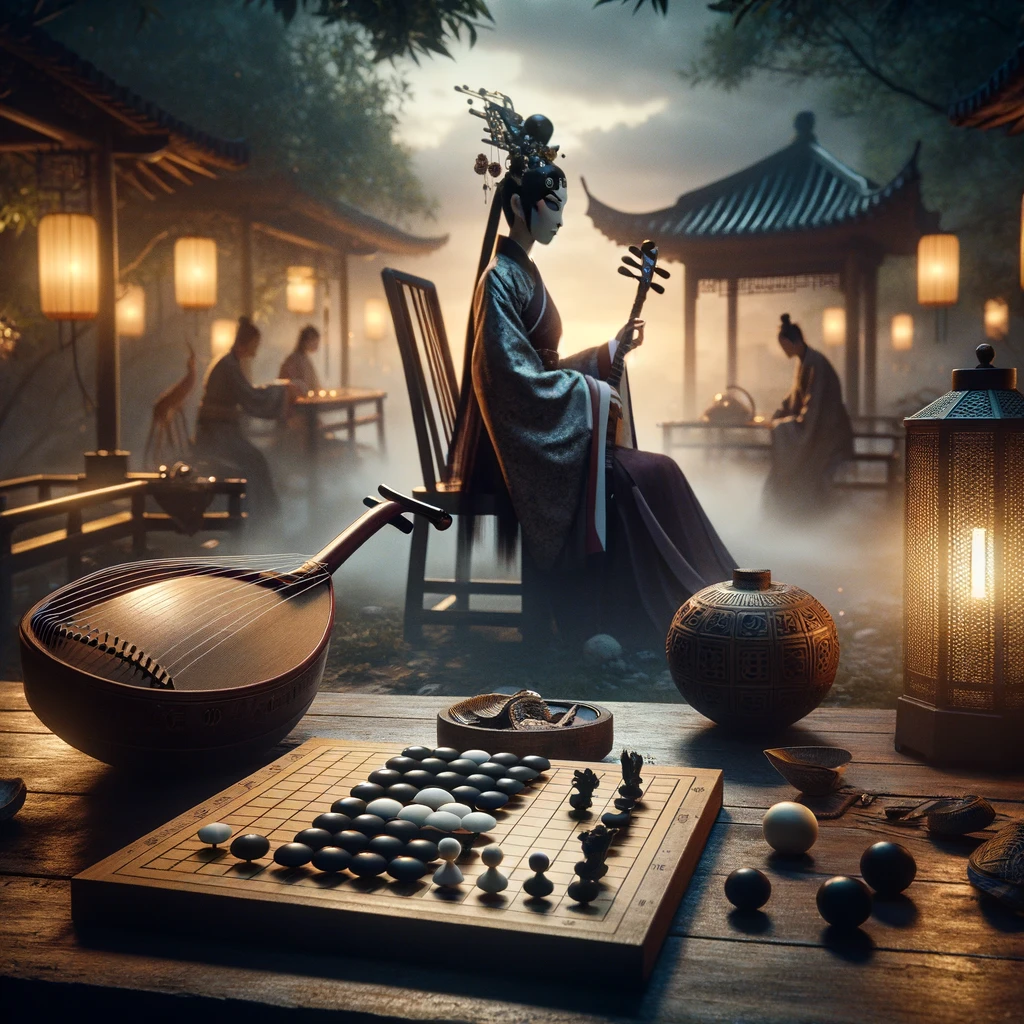GET YOURSELF back in time to a world where the hum of daily life is set to the backdrop of melodious guqin tunes, where the strategic clatter of Go pieces on a board resonates through the air, and where the thrill of Cuju matches ignites the spirit of communities. Welcome to ancient China, a civilization where entertainment and games were not mere pastimes but pivotal elements that wove the social and cultural fabric of an era.
The Essence of Ancient Chinese Leisure

In ancient China, entertainment was a mirror reflecting the values, beliefs, and daily life of its people. It was an intricate tapeletstry that captured the essence of Chinese philosophy, art, and society in its myriad forms:
- Strategic Board Games: Intellectual challenges like Go (Weiqi) and Chinese chess (Xiangqi) that sharpened the mind and fostered an appreciation for strategy and foresight.
- Music and Dance: Ethereal melodies and expressive dances that transcended mere performance to become a conduit for harmony between heaven and earth.
- Sports and Physical Activities: From the team spirit of Cuju, the ancient precursor to football, to the individual discipline of archery, sports in ancient China were as much about physical prowess as they were about moral and ethical development.
- Festivals and Community Gatherings: Vibrant occasions that brought people together, celebrating the cycles of the moon, the harvest, and historical legends with activities that delighted all senses.
A Reflection of Society and Culture
The diversity of entertainment in ancient China speaks volumes about the society itself. It was a reflection of the hierarchical structure, where the imperial court indulged in sophisticated arts and intellectual games, while the common folk found joy in more accessible forms of entertainment. Yet, irrespective of social standing, entertainment served as a unifying force, a shared cultural heritage that brought people together in celebration and contemplation.
Innovations That Transcended Time
The ancient Chinese were pioneers in creating entertainment forms that have transcended centuries:
- The Invention of Paper and the Kite: Innovations that not only revolutionized communication and leisure but also demonstrated the ingenious spirit of the Chinese people.
- The Philosophical Depths of Board Games: Games that were not only entertaining but also imbued with deep philosophical meanings, reflecting the intellectual richness of the culture.
- The Global Influence of Chinese Music and Dance: Art forms that have influenced cultural expressions across Asia and beyond, showcasing the universal appeal of China’s artistic heritage.
A Legacy That Endures
The legacy of ancient Chinese entertainment is a testament to the civilization’s enduring influence on global culture. From the strategic depths of board games that continue to fascinate enthusiasts worldwide to the musical and dance traditions that have inspired countless art forms, the ancient Chinese way of entertainment continues to captivate and enchant.
As we embark on this journey through the vibrant world of ancient Chinese entertainment and games, we uncover not just the leisure activities of a bygone era but the heartbeat of a civilization that continues to inspire awe and admiration. Join us as we explore the rich tapestry of entertainment that defined ancient China, a journey that promises to be as enlightening as it is entertaining.
Interesting Facts to Ponder:
- The game of Go is believed to have been invented more than 4,000 years ago, making it one of the oldest board games still played today.
- Cuju, the ancient form of football, was not only a popular sport but also used as military training during the Han Dynasty.
- The guqin, a revered musical instrument in ancient China, was considered a symbol of a scholar-gentleman’s refined taste and moral character.
This exploration into ancient China’s entertainment landscape reveals not just the cultural richness of the era but also the timeless appeal of its leisure activities. As we delve deeper into each facet of ancient Chinese entertainment, we uncover the enduring legacy that continues to influence and enrich our modern world.
The Melody of Life: Music and Dance in Ancient China
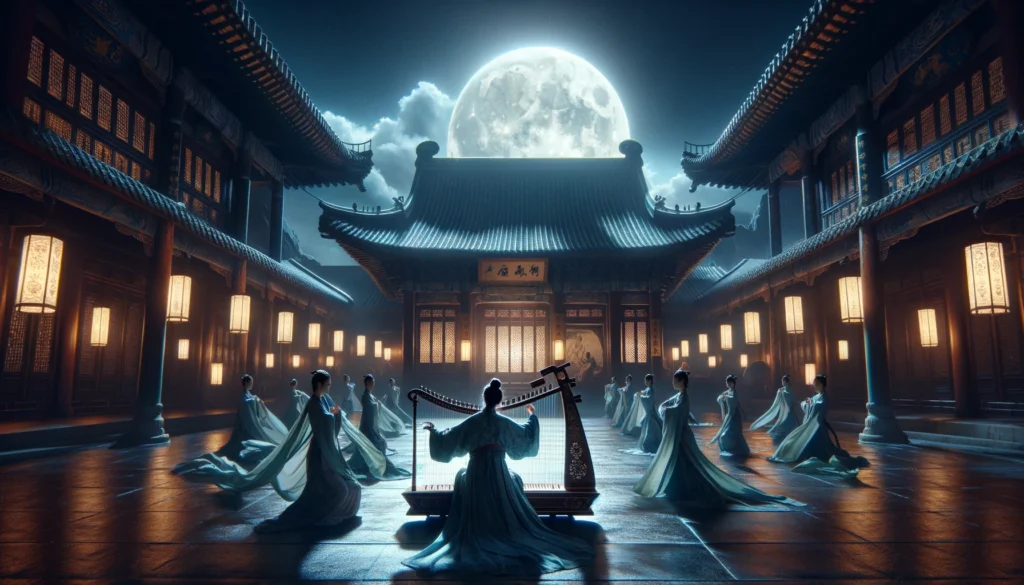
In the tapestry of ancient Chinese culture, music and dance were not mere threads but vibrant colors that painted the essence of life’s celebrations, sorrows, and rituals. These art forms were the soul of society, embodying the philosophical depth and aesthetic beauty revered by the Chinese people.
The Harmony of Ancient Melodies
Music in ancient China was a divine expression, a bridge connecting the human and the celestial. The ancient Chinese believed in the cosmological significance of music, seeing it as a force that could harmonize the universe. This belief was deeply rooted in their musical practices, from the instruments they created to the melodies they composed.
Popular Instruments
- Guqin: The guqin, a seven-stringed zither, was the quintessence of scholarly elegance. Revered as an instrument of the sages, its gentle tones were considered capable of purifying the heart and mind.
- Pipa: The pipa, with its pear-shaped body and four strings, produced sounds that could convey the deepest emotions, from joyous celebrations to the melancholy of parting.
- Erhu: The erhu, a two-stringed bowed instrument, was capable of a wide range of expressions, mimicking everything from the human voice to the sounds of nature.
- Flutes: Bamboo flutes, such as the dizi and xiao, added a lyrical quality to music, evoking images of serene landscapes and flowing rivers.
These instruments were not just tools of entertainment but symbols of cultural refinement and philosophical contemplation.
The Inception of Traditional Chinese Opera
Traditional Chinese opera emerged as a comprehensive art form that integrated music, singing, dance, martial arts, and acrobatics. It was a spectacle of storytelling, where elaborate costumes and expressive masks added layers of meaning to the narratives. Operas often depicted historical events, moral tales, and legends, serving as a medium for educating the public and reinforcing social values.
Rhythms and Rituals
Music and dance in ancient China transcended the boundaries of mere performance, playing pivotal roles in ceremonies, rituals, and everyday life.
Ceremonial and Social Functions
- Court Ceremonies: Music and dance were integral to court ceremonies, symbolizing the harmony between heaven and earth. These performances were meticulously orchestrated to reflect the cosmic order and the emperor’s divine mandate.
- Festivals and Celebrations: During festivals, music and dance became expressions of communal joy and solidarity. The Lantern Festival, for example, was marked by vibrant dances and music that lit up the night.
- Funerals and Memorials: In contrast, solemn music and ritualistic dances were performed at funerals and memorials, honoring the departed and providing solace to the living.
The Impact on Ancient Chinese Society
The profound impact of music and dance on ancient Chinese society is evident in how these art forms were woven into the fabric of daily life. They were not only sources of entertainment but also means of education, moral cultivation, and social cohesion. Music and dance rituals:
- Promoted Confucian ideals of order and harmony.
- Fostered a sense of belonging and collective identity.
- Served as a bridge between the past and the present, preserving cultural heritage and traditions.
Interesting Facts to Consider:
- The “Yue Ji” – Music Record, a classic Chinese text, describes music as a means to “unify and harmonize the hearts of the people.”
- Ancient Chinese orchestras were grand ensembles, sometimes comprising up to hundreds of musicians, showcasing the importance of music in state functions.
- The Dragon Boat Festival features rhythmic drumming that is not just for the excitement of the race but also to ward off evil spirits and bring good luck.
Through the melodies of the guqin and the rhythmic grace of dance, ancient China found a profound way to express its philosophy, emotions, and cultural identity. Music and dance were more than art; they were the heartbeat of a civilization, a melody that continues to echo through time, reminding us of the enduring power of cultural expression.
Strategic Minds: Board Games and Intellectual
Pursuits
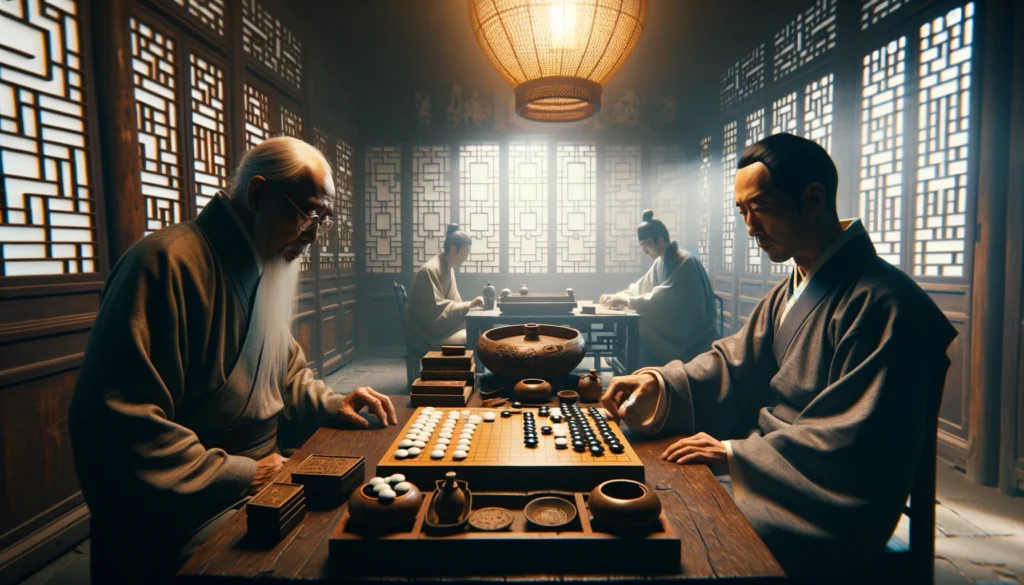
In ancient China, board games were not just popular pastimes; they were arenas for intellectual combat and philosophical exploration. These games, ranging from the strategic battlegrounds of Chinese chess to the abstract territories of Go, were imbued with deep cultural significance and intellectual rigor.
The Art of War and Peace: Chinese Chess (Xiangqi)
Chinese chess, or Xiangqi, stands as a testament to the strategic depth and cultural importance that board games held in ancient China. With origins dating back to the Warring States period, Xiangqi is a game of military strategy that simulates a battlefield where two armies vie for dominance.
- Strategic Depth: Each piece in Xiangqi represents different military ranks with unique movements, reflecting the hierarchical nature of ancient Chinese armies. The game’s objective, to capture the opponent’s general, demands foresight, strategy, and tactical acumen, mirroring the complexities of real-life military engagements.
- Cultural Importance: Xiangqi is more than a game; it’s a cultural artifact that encapsulates ancient Chinese military theory, particularly the principles found in Sun Tzu’s “The Art of War.” It serves as a tool for teaching strategy, patience, and the art of balancing aggression with defense.
Go: Beyond the Board
Go, known as Weiqi in China, is perhaps the oldest board game still played in its original form. Its simplicity in design belies the profound strategic and philosophical depth it contains.
- Philosophical Implications: Go is a game of territorial encirclement, where the aim is to control more of the board than your opponent. It embodies the Taoist philosophy of balance and the Buddhist concept of impermanence, as the fluidity of the board reflects the ever-changing nature of life itself.
- Historical Significance: With origins tracing back nearly 4,000 years, Go has been a staple of Chinese intellectual and cultural life, enjoyed by emperors and commoners alike. It was considered one of the four essential arts of a cultured Chinese scholar, alongside calligraphy, painting, and playing the guqin.
A Deck of Dynasties: Card Games and Board Games
The evolution of card and board games in ancient China reflects the society’s ingenuity and love for intellectual leisure. These games varied widely, from the competitive matching games played with leaves or paper cards to the intricate board games that mapped the cosmos.
- Societal Role: These games were more than entertainment; they were social conduits, bringing together people from various walks of life. In the imperial court, they were a means of socializing and political maneuvering, while among the common folk, they provided a much-needed respite from the rigors of daily life.
- Evolution and Variety: The diversity of games played in ancient China is a testament to the culture’s inventiveness. Games like Liubo, a board game with a cosmological dimension, and Mahjong, whose modern form was developed much later, showcase the evolution of leisure activities over the centuries.
Athletic Valor: Sports and Outdoor Activities in Ancient China
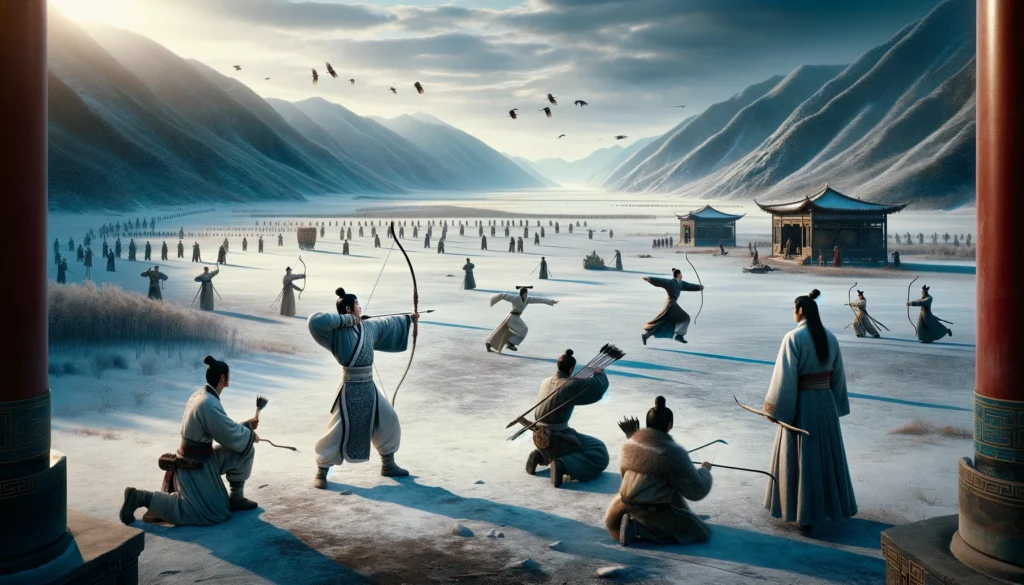
Ancient China’s approach to sports and outdoor activities was holistic, emphasizing not just physical prowess but also moral and ethical development. From the team spirit of Cuju to the disciplined focus required in archery, these activities reflected the values and virtues of ancient Chinese society.
Cuju: The Ancient Ancestor of Football
Cuju, literally “kick ball,” is recognized as the ancient ancestor of modern football (soccer). Originating during the Han Dynasty, it was both a popular form of entertainment and a rigorous military training exercise.
- Origins and Rules: Played with a leather ball filled with feathers and hair, and goalposts that varied in form, Cuju required skill, agility, and teamwork. The game had different variations, from competitive matches between teams to performance-based exhibitions where the aim was to keep the ball in the air.
- Reflection of Martial Virtues: Cuju was more than a game; it was a reflection of the martial virtues prized in ancient Chinese society, such as discipline, teamwork, and strategic thinking. It was even used as a form of military training, emphasizing the importance of physical fitness and agility in combat.
Chuiwan and Polo: Leisure of the Elite
While Cuju was enjoyed by people from various social strata, Chuiwan (an ancient form of golf) and polo were particularly favored by the nobility. These sports offered a blend of physical activity, social interaction, and leisure.
- Chuiwan: Played with a set of clubs and balls, Chuiwan involved hitting the ball into holes marked across the playing field. It was a leisurely sport that allowed for strategic thinking and physical exercise, enjoyed by emperors and the elite.
- Polo: Introduced from Persia, polo became popular among Chinese nobility, with lavish matches often held in the imperial courts. It required skillful horsem
anship and was a symbol of status and wealth.
From Archery to Ice Skating: A Spectrum of Sports
The range of sports and outdoor activities in ancient China is indicative of the society’s appreciation for diverse forms of physical expression and entertainment.
- Archery: Considered one of the Six Arts during the Zhou Dynasty, archery was both a sport and a crucial military skill, embodying the virtues of precision, control, and patience.
- Ice Skating: During the Song Dynasty, ice skating on frozen lakes and rivers became a popular winter activity, showcasing the adaptability and inventiveness of the ancient Chinese in their pursuit of leisure.
Each of these activities, from the intellectually stimulating board games to the physically demanding sports, played a vital role in the cultural and social life of ancient China. They were not merely forms of entertainment but expressions of the values, philosophies, and aesthetics that defined this great civilization.
Entertainment Across the Social Spectrum

The rich tapestry of ancient Chinese entertainment was woven with threads of diversity, where the fabric of society—its classes, traditions, and values—played a crucial role in shaping the nature of leisure and amusement.
The Divide of Delight: Entertainment Among Social Classes
In ancient China, the spectrum of entertainment spanned from the opulent halls of the imperial palace to the bustling streets of the commoners’ quarters. This divide was not just a matter of wealth but also a reflection of societal structures and priorities.
- Imperial Banquets and Court Performances: The elite enjoyed elaborate entertainments such as grand banquets, where music, dance, and theatrical performances were staged for the pleasure of the emperor and his court. These events were showcases of sophistication, with every detail meant to reflect the power and cultural refinement of the ruling class.
- Folk Games and Street Festivals: Contrarily, the common people found joy in simpler, more accessible forms of entertainment. Street festivals, puppet shows, storytelling sessions, and folk games were integral to communal life, offering respite from the toils of daily existence and strengthening bonds within the community.
Common Joy and Noble Pursuits: A Contrast
Despite the stark differences in the modes of entertainment across social strata, there existed a universal appreciation for the joy and community spirit that these activities fostered. Whether it was a nobleman practicing calligraphy or a farmer engaging in a spirited game of Cuju, the pursuit of leisure and cultural enrichment knew no social bounds.
Legacy and Cultural Significance
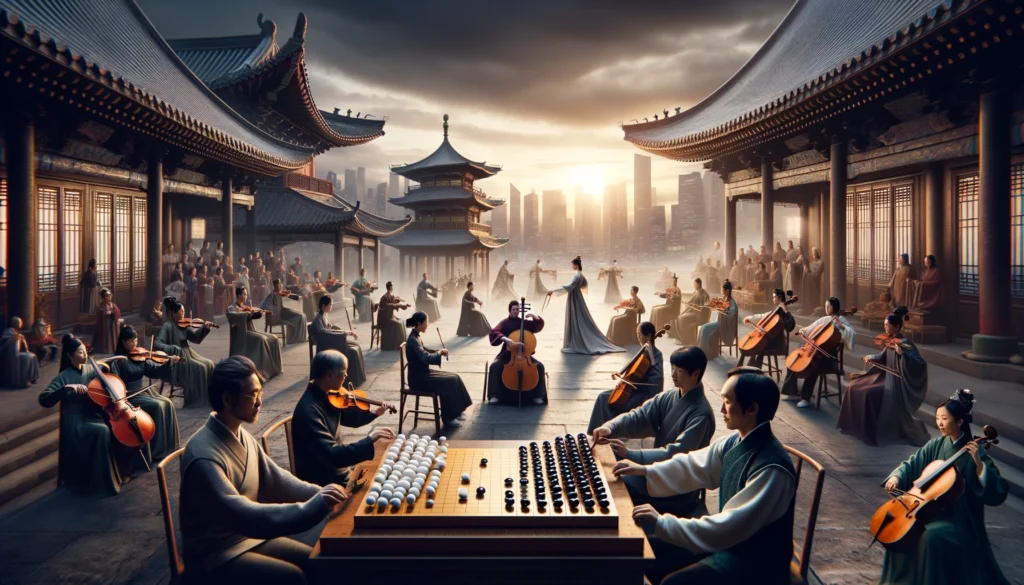
The entertainments of ancient China have left an indelible mark on modern culture, both within China and across the globe. Their legacy is a testament to the enduring power of cultural traditions and their ability to adapt and evolve over millennia.
Echoes of Ancient Joy: Influence on Modern Culture
- Festivals and Celebrations: Many of today’s Chinese festivals, such as the Dragon Boat Festival and the Mid-Autumn Festival, have their roots in ancient traditions, where music, dance, and games played central roles. These events continue to bring people together, celebrating cultural heritage and communal ties.
- Martial Arts and Philosophical Strategies: The global fascination with Chinese martial arts and the strategic depth of games like Go and Chinese chess highlight the widespread influence of ancient Chinese practices on contemporary leisure and competitive activities.
The Global Stage: Ancient China’s Entertainment Legacy

The reach of ancient Chinese entertainment extends far beyond its geographical origins. From the philosophical teachings embedded in board games to the global practice of Tai Chi and other martial arts, these ancient pastimes have shaped cultural expressions and leisure activities around the world.
Conclusion: A Timeless Tapestry
The entertainment landscape of ancient China was a dynamic and multifaceted domain, reflecting the complexities of its society and the rich cultural heritage of the Chinese people. From the strategic intricacies of board games to the communal joy of festivals, these activities were more than mere pastimes; they were vital expressions of human creativity, social cohesion, and cultural identity.
As we reflect on the diverse nature of ancient Chinese entertainment, we are reminded of its lasting impact on both Chinese and global culture. These ancient forms of leisure and amusement continue to resonate today, bridging past and present, and reminding us of the universal human need for connection, joy, and cultural expression.
FAQ: Ancient Chinese Entertainment and Games
Q1: What were the most popular forms of entertainment in ancient China?
A1: The most popular forms of entertainment varied widely and included music, dance, board games like Go and Chinese chess, martial arts, kite flying, and traditional sports like Cuju (ancient football) and archery. These activities reflected the diverse interests and cultural values of ancient Chinese society.
Q2: How did social class affect entertainment in ancient China?
A2: Entertainment in ancient China differed significantly across social classes. The imperial court and the nobility enjoyed lavish entertainments such as grand banquets, court music, and dance performances. In contrast, common folk engaged in more accessible activities like street festivals, puppet shows, storytelling, and folk games.
Q3: What is the significance of the game Go in ancient Chinese culture?
A3: Go (Weiqi) is one of the oldest board games in the world and was highly esteemed in ancient Chinese culture. It was considered one of the four essential arts of a cultured scholar. The game is renowned for its strategic depth and philosophical implications, embodying the principles of balance, strategy, and adaptation.
Q4: Were ancient Chinese sports only for entertainment, or did they serve other purposes?
A4: While ancient Chinese sports provided entertainment, they also served various educational and military training purposes. Sports like Cuju (ancient football) and archery were incorporated into military training to improve soldiers’ physical fitness, discipline, and tactical skills. Additionally, sports and physical activities were seen as ways to cultivate moral virtues and social harmony.
Q5: How has ancient Chinese entertainment influenced modern culture?
A5: Ancient Chinese entertainment has profoundly influenced modern culture, both within China and globally. Festivals like the Dragon Boat Festival and the Mid-Autumn Festival continue to be celebrated, preserving ancient traditions. The strategic principles found in games like Go and Chinese chess have been studied for their intellectual depth. Moreover, Chinese martial arts, traditional music, and dance have gained international popularity, showcasing the enduring appeal of China’s cultural heritage.
Q6: Are there any resources where I can learn more about ancient Chinese entertainment and games?
A6: Yes, numerous resources are available for those interested in exploring ancient Chinese entertainment further. Academic articles, books on Chinese history and culture, cultural heritage websites, and online museum collections offer in-depth information. Additionally, YouTube channels dedicated to historical reenactments and documentaries provide visual and auditory insights into these traditional forms of entertainment.
Q7: How did ancient Chinese view the role of entertainment and games in society?
A7: Entertainment and games in ancient China were viewed as essential components of a balanced life, contributing to moral education, social cohesion, and personal enjoyment. They were seen as means to cultivate virtues, foster artistic and intellectual growth, and strengthen community bonds. This holistic view underscores the cultural importance of leisure activities in ancient Chinese society.
Explore Further: Key Takeaways and Additional Resources
To dive deeper into the enchanting world of ancient Chinese entertainment, consider exploring the following resources:
- Articles and Books: Look for scholarly articles and books that delve into the history and cultural significance of specific forms of ancient Chinese entertainment.
- Websites: Visit cultural heritage websites and online museums that offer insights into ancient Chinese society and its leisure activities.
- YouTube Videos: Watch documentaries and reenactments that bring to life the music, dance, and games of ancient China, offering a visual and auditory experience of these traditional arts.
By expanding our understanding of ancient Chinese entertainment, we not only gain insight into a rich cultural past but also appreciate the ways in which these ancient traditions continue to enrich our lives today.
